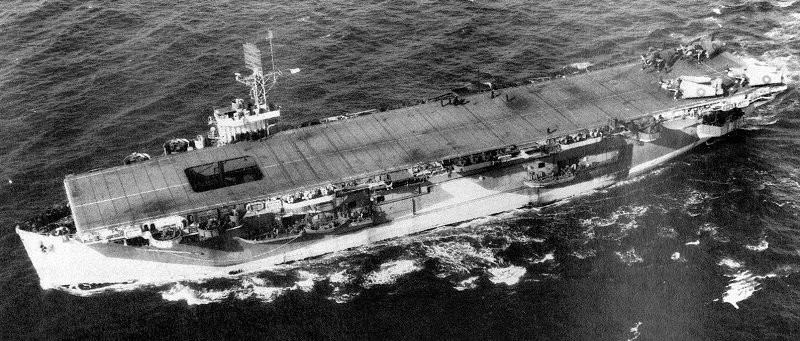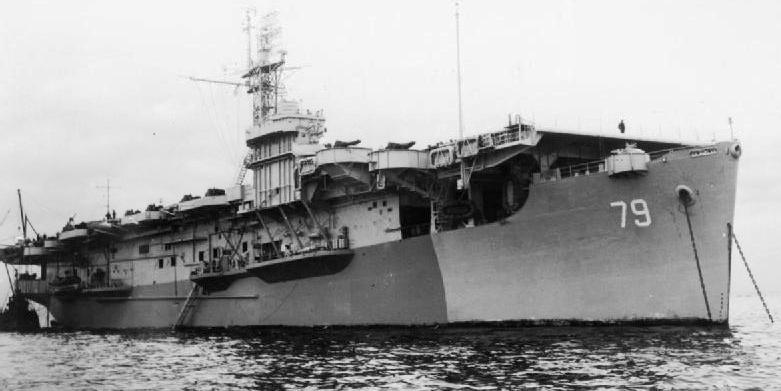Royal Navy Aircraft Carriers HMS Nabob and HMS Puncher, manned by RCN crews, 1944–1945
Royal Navy aircraft carriers manned by RCN crews during the Second World War
HMS Nabob (D77) (Ruler-class escort aircraft carrier); HMS Puncher (D79) (Ameer-class).
HMS Nabob (D77)

(Shearwater Aviation Museum Photo)
HMS Nabob (D77) at sea before being transferred to the RCN.
HMS Nabob (D77) was a Ruler-class escort aircraft carrier which served in the Royal Navy during 1943 and 1944. The ship was built in the United States as USS Edisto (CVE-41) (originally AVG-41 then later ACV-41) but did not serve with the United States Navy. She was laid down on 20 October 1942, launched 22 March 1943, and transferred under Lend-Lease to the United Kingdom on 7 September 1943 prior to her commissioning as HMS Nabob (D77) into the Royal Navy. She served as an anti-submarine warfare carrier and the ship's crew was largely drawn from personnel provided by the Royal Canadian Navy. Flight crew were Royal Navy personnel (No. 852 and No. 856 Naval Air Squadrons of the Fleet Air Arm).
After training the ship went to San Diego and took the 852 FAA-Sqdn on board, equipped with Avenger aircraft. She then proceeded with HMCS New Waterford (K321) via the Panama Canal to Norfolk, where 45 Republic P-47 Thunderbolt fighters were embarked as deck load and US Army Air Force personnel were taken on board as passengers when the ship made passage to the UK in convoy VT-10. There, it joined the Home Fleet after disembarking the fighters. In April 1944, four Grumman Martlet (Wildcat) Mk. V fighters were added to the No. 852 Squadron, FAA, while a detachment of the No. 856 Squadron, FAA, equipped with Grumman Avenger Mk. II aircraft joined the escort carrier in June. The ship then participated in Operation Offspring, a great mine lying operation off Norway.

(Library and Archives Canada Photo, MIKAN No. 3198918)
HMS Nabob, starboard quarter, January 1944.

(Library and Archives Canada Photo, MIKAN No. 3230534)
HMS Nabob (D77), RCN 40-mm Bofors AA Gun Mk. XI in Twin Mounting, crew engaged practice firing, Jan 1944.

(Bruce Jones Photo)
HMS Nabob (D77)

(Corvus Publishing Group Photo, Canada's Navy)
HMS Nabob (D77), off the coast of California during her post-modification workup with Grumman Avenger torpedo bombers of No. 852 Squadron, March 1944.

(CFB Esquimalt Naval & Military Museum Photo)
HMS Nabob (D77) stuck fast on a sand bar, one of 850 squadron's Avengers flying over head. MS RANEE, in the background, has arrived to lend assistance.

(IWM Photo, A.25368)
HMS Nabob (D77). On 22 August 1944, while returning from a strike against the German battleship Tirpitz (Operation Goodwood), she was torpedoed by U-354 in the Barents Sea and sustained heavy damage. The damaged carrier is shown steaming under her own power for Scapa Flow. At 01.14 hours on 22 Aug 1944 the U-boat fired a spread of FAT torpedoes and hit the HMS Nabob (D 77) with one torpedo in the starboard side aft, resulting in a hole about 32 feet square located aft of the engine room and below the waterline. At 01.22 hours, the U-boat fired a Gnat to finish off the carrier, but struck the HMS Bickerton (K466) instead, which was about to begin refuelling the escort carrier at the time of the attack. The frigate was subsequently scuttled by a torpedo from the HMS Vigilant (R93).
The stern of the HMS Nabob (D77) quickly sank 15 feet and the power went off. The fans in the engine room stopped and the main engines had to be shut down because the temperature had soared to 150 degrees. As the ship lay dead in the water, 205 men were evacuated from the ship and transferred to the Canadian destroyer HMCS Algonquin by boats and Carley floats, two weeks later they were transferred to the HMS Zest (R02) near the Faeroe Islands and finally brought to Scapa Flow. The remaining crew worked hard to get the ship under control. Emergency diesel generators were used to get power for the pumps to limit the flooding, but the engine room bulkheads bulged inward from the pressure of the sea that had rushed in through the hole. Heavy gear was ditched or brought to the bow to improve the trim, including the two 5-inch guns, which were removed with cutting torches and dropped overboard. This helped raise the stern so there was not as much pressure on the drive shaft bearings. In the early evening, the escort carrier was underway again at 10 knots.
Early the next morning, an HF/DF bearing and a surface contact indicated that a U-boat was in the area. Two Avengers managed to launch from the sloping deck and kept the U-boat under water for three and a half hours. The first returned and made a good landing, but the second crashed and damaged six other aircraft on deck. The damaged torpedo bombers were later jettisoned.
Despite her damaged condition, HMS Nabob turned homeward with a skeleton crew and reached her base after sailing 1,070 miles at a steady ten knots, proceeding homewards under her own steam, her stern low down in the water. On 27 August, the ship reached Scapa Flow under her own power. As the carrier's galley had been destroyed the skeleton crew lived on short rations and rum for the five days it took to get the ship home.

(RN Photo)
HMS Nabob (D77), down by the stern after the torpedo strike.

(IWM Photo, A.25689)
HMS Nabob, entering the main dry dock at Rosyth, Scotland, on 18 September 1944.
HMS Nabob had lost 21 men. She was eventually judged not worth repairing, was beached and abandoned, and then cannibalized for other ships. She was decommissioned on 30 September 1944, but was retained as part of the Reserve Fleet. She was returned to USN at Rosyth and stricken for disposal 16 March 1946. She was sold for scrapping in the Netherlands in March 1947, but was resold and converted as the merchant ship Nabob of Norddeutscher Lloyd (she was later renamed Glory and registered in Panama). She was sold for scrap in Taiwan in 1977. HMS Nabob was one of three Royal Navy escort carriers built in the United States which were listed as lost in action (2 sunk and 1 heavily damaged and never repaired) during the Second World War.
These ships were all larger and had a greater aircraft capacity than all the preceding American built escort carriers. They were also all laid down as escort carriers and not converted merchant ships. All the ships had a complement of 646 men and an overall length of 492 feet 3 inches (150.0 m), a beam of 69 feet 6 inches (21.2 m) and a draught of 25 ft 6 in (7.8 m). Propulsion was provided a steam turbine, two boilers connected to one shaft giving 9,350 brake horsepower (SHP), which could propel the ship at 16.5 knots (30.6 km/h; 19.0 mph). Aircraft facilities were a small combined bridge–flight control on the starboard side, two aircraft lifts 43 feet (13.1 m) by 34 feet (10.4 m), one aircraft catapult and nine arrestor wires. Aircraft could be housed in the 260 feet (79.2 m) by 62 feet (18.9 m) hangar below the flight deck. Armament comprised: two 4 inch Dual Purpose guns in single mounts, sixteen 40-mm Bofors anti-aircraft guns in twin mounts and twenty 20-mm Oerlikon anti-aircraft cannons in single mounts. They had a maximum aircraft capacity of twenty-four aircraft which could be a mixture of Grumman Martlet, Vought F4U Corsair or Hawker Sea Hurricane fighter aircraft and Fairey Swordfish or Grumman Avenger anti-submarine aircraft.

(Bruce Jones Photo)
HMS Nabob.

(Official USN Photo, located at the US National Archives)
HMS Nabob.
HMS Puncher

(Alanfor SVallely Photo)
HMS Puncher (D79).
HMS Puncher (D79), originally named USS Willapa (AVG-53/ACV-53/CVE-53) was a Bogue-class escort aircraft carrier (originally an auxiliary aircraft carrier) in the United States Navy, leased to the United Kingdom. Willapa was laid down on 21 May 1943 at Seattle, Washington, by the Seattle-Tacoma Shipbuilding Corporation and reclassified CVE-53 on 10 June 1943. Launched on 8 November 1943, the ship was transferred under lend-lease to the Royal Navy on 5 February 1944 to be manned by a Canadian crew. Renamed HMS Puncher (D79), the carrier served the Royal Canadian Navy except for Fleet Air Arm personnel in the Atlantic and Mediterranean for the duration of hostilities. Stationed with the Home Fleet at Scapa Flow, Puncher initially served in a training role, but was re-tasked to strike and convoy air protection (CAP) after her sister ship, HMS Nabob was torpedoed off Norway in 1944. Also part of her squadron was the US escort carrier USS Shamrock Bay. Puncher also provided convoy air protection on the Murmansk/Arkhangelsk convoy route which she did six times. Strike operations included against German occupied Norway industrial and shipping targets such as the steel works at Narvik on the west coast of Norway. Fleet Air Arm squadrons assigned to Puncher included Fairey Barracuda torpedo bombers, Fairey Firefly fighter/bombers, American-built Hellcat (Wildcat) fighters and Avenger torpedo bombers. The Barracuda was one of the largest carrier-borne aircraft in the Royal Navy Fleet Air Arm and required rocket assistance to take flight from the small flight deck. The Admiralty had determined that, in the post-war world, Canada would have her own aircraft carriers. Both HMS Puncher and HMS Nabob were crewed by RCN crews to establish the knowledge base for the future carriers assigned to that country, HMCS Warrior (ex HMS Warrior), HMCS Magnificent (ex HMS Magnificent) ("The Maggie"), and HMCS Bonaventure (ex HMS Powerful) ("The Bonnie"). Decommissioned on 16 February 1946 at Norfolk, Virginia, and returned to American custody that day, the escort carrier was struck from the Navy Registry on 12 March 1946, having never seen active service with the United States Navy. Initially sold to William B. St. John, of New York City, on 9 January 1947, the carrier was subsequently resold to a British firm on 4 February 1947 and converted for mercantile service. She later served successively as Muncaster Castle, Bardic and Ben Nevis until she was scrapped in Taiwan in 1973.

(IWM Photo, A25712)
HMS Puncher (D79).

(IWM Photo, FL 17755)
HMS Puncher (D79) at anchor.

(Shearwater Aviation Museum Photo)
HMS Puncher (D79).

(Official USN Photo, located at the US National Archives)
HMS Puncher (D79).

(Official USN Photo, located at the US National Archives)
HMS Puncher (D79).

